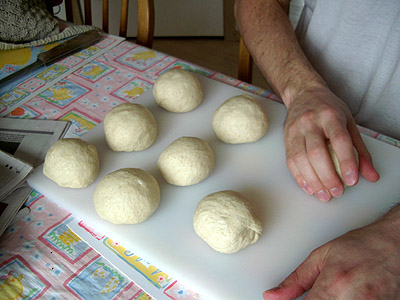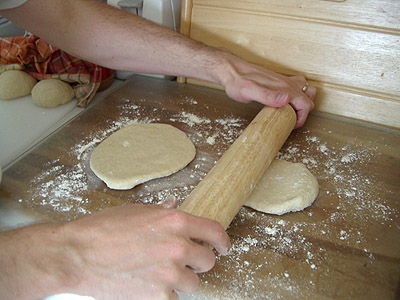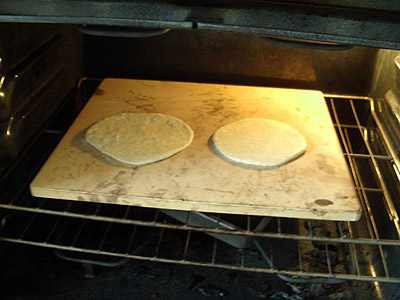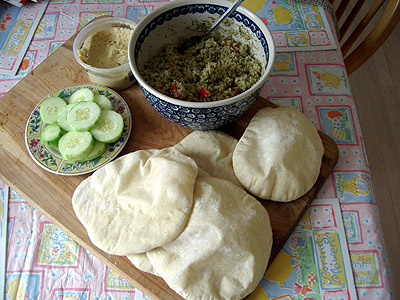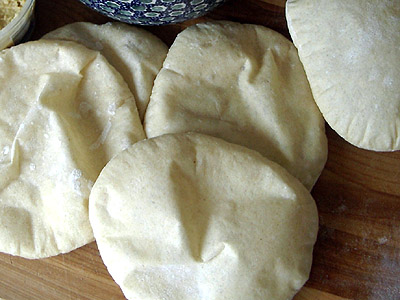 Pita bread is a great bread for beginning bakers or for making with kids. The entire process of making them only takes about two hours too, so it is also a great one for people on a tight schedule.
Pita bread is a great bread for beginning bakers or for making with kids. The entire process of making them only takes about two hours too, so it is also a great one for people on a tight schedule.
Flat Breads
Flat breads can be made in dozens of different ways. They can be made from grains other than wheat, such as corn in corn tortillas. They can be made with no leavening, such as matzo or flour tortillas, with chemical leavening (baking soda or baking powder) such as pancakes or crepes, or with yeast, such as naan or pita bread. They can also be made from a starter. And they can be baked (pitas), fried (fry bread), grilled (zebra bread), and, I would imagine even steamed (I'm drawing a blank... anyone?). Flat breads of some sort exist in just about every culture on the globe.
Anyone who grew up in a household where flat breads are an essential part of every meal knows will attest that they are a hundred times better when baked fresh than when bought from the store wrapped in plastic and already two or three days old.
I wasn't brought up in such a house, actually, but a year or two ago I started going to a local Lebanese restaurant solely for the fresh pita bread that they baked. After draining my wallet by eating lunch there every day for a week, I realized pita bread must be pretty simple to make at home. So I tried it and was extremely pleased with the results. I still visit the Lebanese restaurant for their pitas every few weeks, but I've cut back and saved myself a ton of money.
About The Ingredients
There are only 6 ingredients in this recipe for pita bread, and you even have quite a bit of flexibility in choosing which of those to include. I'll go through the ingredients one-by-one:
- Flour - I like to use one cup of whole wheat flour and 2 cups of all purpose unbleached flour. It gives the pitas a heartier flavor than using all white flour. You can use any combination of the wheat flours you have around the house, from 100% white flour to 100% whole wheat flour. You could probably even use flour made from other grains, though I'd suggest trying it with wheat flour the first time before getting too crazy.
- Salt - Salt is necessary to retard the yeast (slow it down) and to flavor the bread. Without salt bread is pretty... blah. I used kosher salt for this, but any type of salt you have in the house will work just fine.
- Water - Plain old tap water, assuming your water is drinkable. If not, bottled or distilled water. Something close to room temperature (warmer than 50 degrees fahrenheit, cooler than 100 degrees) works best.
- Sugar - A touch of sugar or honey provides a little more food for the yeast and will make the bread brown faster when it caramelizes. It also can add a touch of sweetness to the dough. You can safely omit it from the recipe and it will turn out fine, or add more if you like it sweeter.
- Yeast- I use instant yeast, which is also know as Rapid Rise or Bread Machine yeast. Instant yeast is a little more potent than active dry yeast and can be mixed directly in with your dry ingredients and will have no problem waking up when the water is added. Active dry yeast works just as well as instant yeast, but requires being activated in a little bit of warm water before being added to the rest of the ingredients. If you are using active dry yeast, read the instructions on the package to figure out how to activate the yeast before adding it to this recipe and reduce the amount of water you add later in the recipe by the amount of water you proof the yeast in (i.e., if you activate the yeast in a half a cup of water only add 3/4 to 1 cup later).
- Oil - Oil or fats soften the bread and keep it fresher longer. Olive oil is the most traditional oil to use in Mediterranean and Middle Eastern cooking, but if you do not have any you can use whatever you have in the house. And, in the worst case, you can even omit it.

